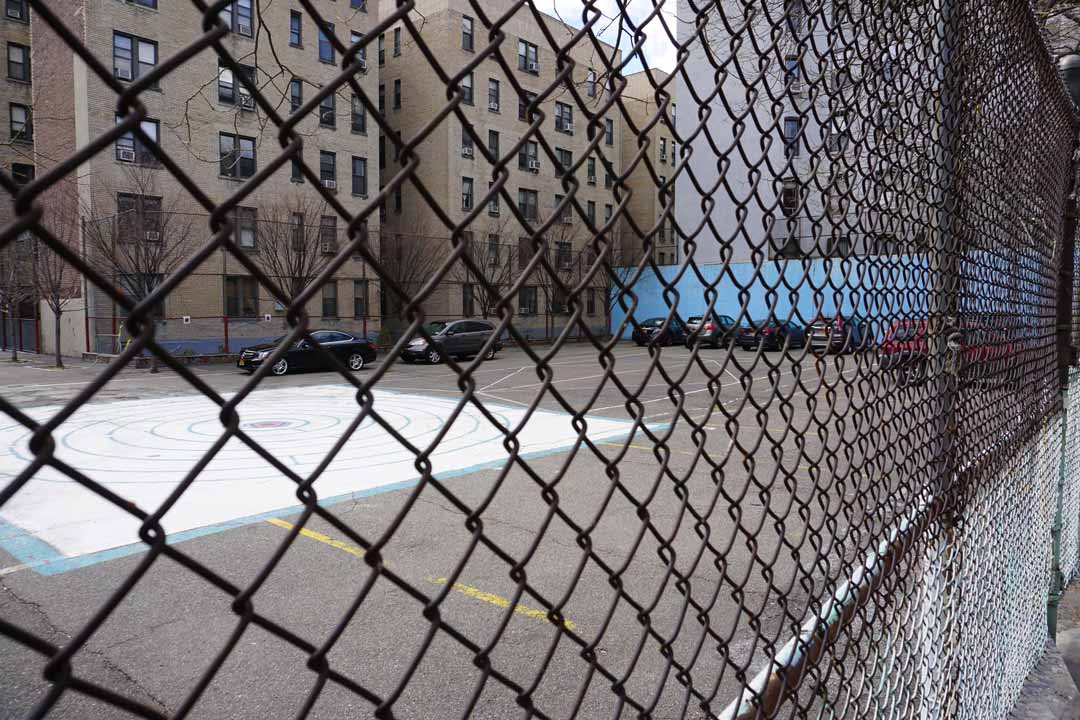BY FRANK MASTROPOLO | There is no shortage of pricey gyms and health clubs in the East Village, where you can pay up to $100 a month to work out on high-tech equipment. But what if you’d like a neighborhood playground that’s free — where you can play handball or softball or run track? They’re not as easy to find.
There is a playground that is part of the Manhattan School for Career Development, at 113 E. Fourth St., between First and Second Aves. The L-shaped site runs through the block to E. Fifth St. There are two basketball hoops here and no shortage of space; the basketball court at Madison Square Garden would fit comfortably.
Students shoot hoops and hang out for a few hours on school days. But don’t think about honing your basketball skills here any other time. Most of the “playground” is not for play at all. It is used as a parking lot by the school’s teachers and paraprofessionals and remains locked at all times to the community.

This policy is in contrast to many school playgrounds operated by the Parks Department. For example, McKinley Park, at nearby P.S. 63 on E. Third St., is open to the public year-round except when school is in session.
It seems an odd choice for the Department of Education to deny neighborhood kids and adults a place to play and exercise. D.O.E. did not respond to requests for comment.
Stuart Zamsky, a longtime East Village resident, said that in the 1990s, the community was welcome to use the E. Fourth St. playground.
“It was unorganized,” said Zamsky, an officer in the E. Fifth St. Block Association. “It would be a group of kids or a dad and a son or a couple of buddies, just throwing a ball around or doing pitching practice or batting practice or semi-organized games, pickup games.
“It usually was younger people, as opposed to college kids. And super-local,” Zamsky recalled, “a disparate group — Indians, blacks, whites, neighborhood ne’er-do-wells, the whole gamut.”
There was no public clamor when the school locked the playground’s gates.
“I think we voiced a little protest. The school had it closed,” Zamsky said. “It’s up to the school, it’s their park. So there really is no talking to anyone. Having it closed is within their rights — that became clear as we tried to keep it open.”
But the community, Zamsky said, bears some blame.
“It was insane dog walkers,” he said. “Someone would be on the phone and aimlessly wandering as their dog was on the opposite corner of the park, crapping it up.
“It’s a school. Kids go play there. If they come in there Monday and there’s dog s— all over the place, there’s no way to justify that. The school custodian has to clean it up or the kids have to clean it up.”
“That entire playground is school property,” Councilmember Rosie Mendez said. “There are some playgrounds that are jointly operated between Parks and a school. This is not one of those.
“You need someone to open it, someone to close it, someone to clean it,” Mendez explained. “And in a lot of my playgrounds and some of my parks, there are a lot of needles being left there. So, if children are going to be going into that playground, you have to ensure it’s clean.”
Mendez maintained that tight education budgets make keeping playgrounds open hard for schools.
“If you need to have extra custodial staff cleaning the outside of the school, so that school children can utilize that playground, it impacts your budget,” she said. “If you have people spending too much time in the playground to get it cleaned before the school opens up, are the classrooms going to be adequately cleaned, or do you have to hire additional staff?
“Unfortunately,” Mendez said, “the city is not providing enough to the school’s budget to do everything that they need to do.”
Added state Senator Brad Hoylman, “Clearly, in a neighborhood that’s as park-starved as the East Village, we want to make sure we maximize the public space available to the community.
“If it’s a good idea, then we should examine the possibility of opening the space for the public,” Hoylman said. “There may be costs. There might be considerations for the school on safety and security. But the Department of Education and Parks Department will help guide us.”
Borough President Gale Brewer suggested that Parks might provide a solution.
“Whenever it’s practical, we should find ways for school playgrounds and other open spaces to be enjoyed by the public outside of school hours,” Brewer said. “The question is whether the Parks Department can take over responsibility for the park outside school hours without pulling resources away from its existing commitments. I’ll be reaching out to the school, D.O.E. and Parks to see if we can make it work at the playground on Fifth St.”
“I’d be very eager to hear how the community board feels on this issue,” Hoylman said, adding he supports Brewer’s efforts to convene a meeting on the issue.

















